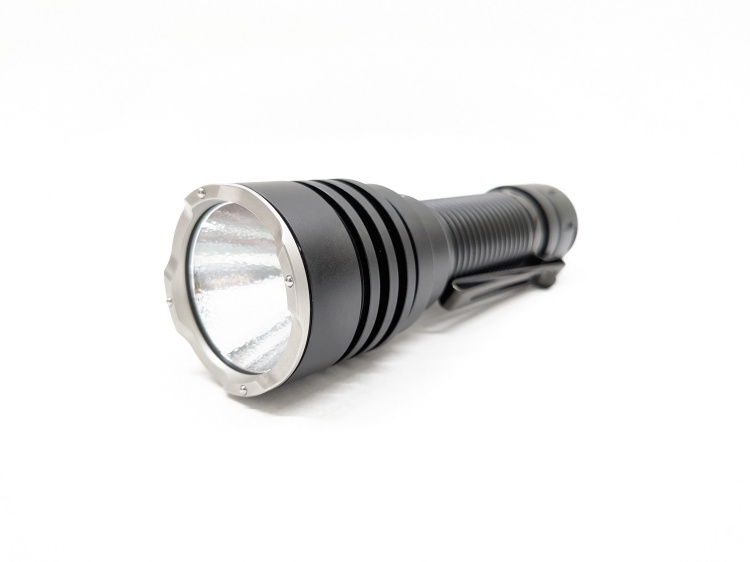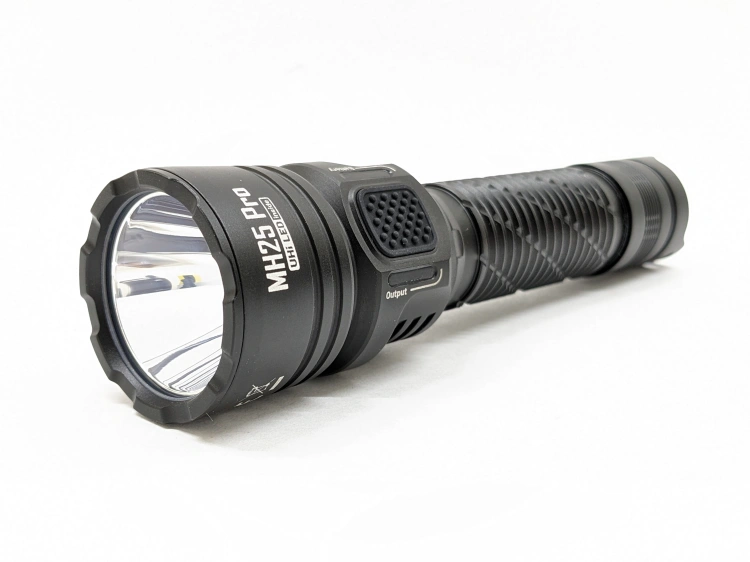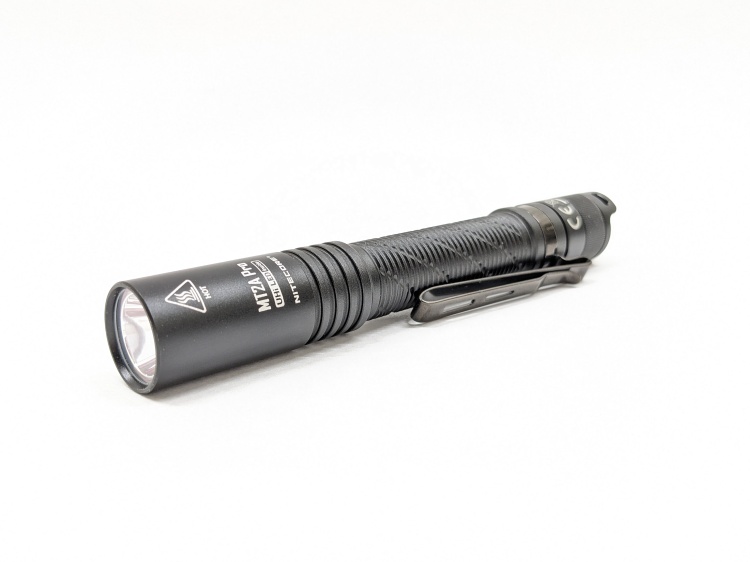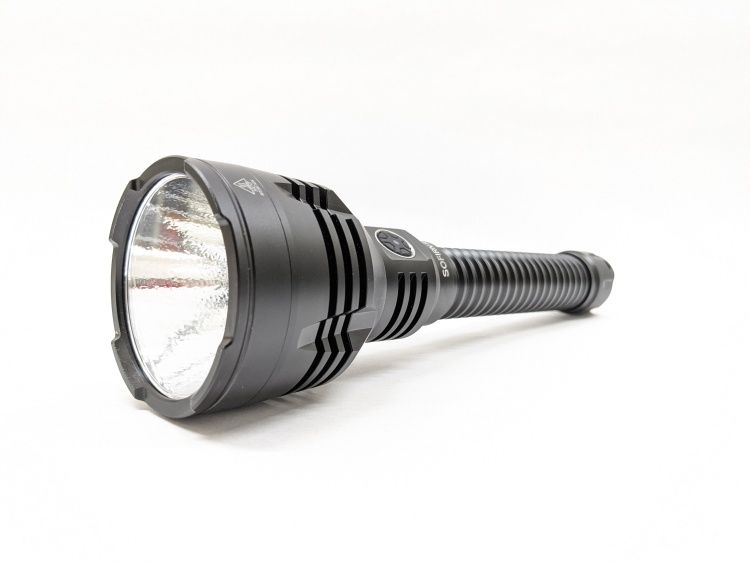Contents
- The Boring Stuff
- What comes in the box?
- Design & Construction
- Size & Measurements
- User Interface
- Modes, Brightness, Throw, & Tint
- Runtime
- Driver & Regulation
- Emitter & Beam
- Switch
- Carry & Ergonomics
- Batteries & Charging
- Competition
- Conclusion
The Boring Stuff
I purchased this light with my own money from Neal’s Gadgets. Here is the official product page, and be sure to check the BLF group buy to see if there’s a coupon to make the price even lower! Neal has gotten a bad reputation in the past, but I’ve ordered from him four times now and have had a great experience every time and his customer service has been good. Below are the official specs.

What comes in the box?
This is officially the jankiest flashlight packaging I’ve seen. The light came in two halves of a cardboard box mushed and taped together. Inside was an un-marked thin white cardstock box which held the light wrapped in a bubblewrap sleeve. The only thing included is the light itself. There are no accessories whatsoever. It keeps the cost down though, which is a good thing.
Design & Construction
The design is excellent. It’s a very attractive host that looks very “flashlight-ey” as Zeroair would say. I love the look of the black anodizing and the optional stainless steel bezel. Based on the shape, it looks like a thrower because that’s what most lights this shape are, but this one is very floody and I think the shape makes it pretty unique. The bezel says “CHAOS” on it for some reason.
Build quality is excellent. No qualms whatsoever from me. The threads are smooth, lubricated, trapezoid cut, and all the exact same size and pitch. Curiously, they’re un-anodized; probably to keep resistance low. That does mean mechanical lockout won’t work though. Also curious is that every body tube joint is double o-ring sealed. I wouldn’t take this light diving by any means, but that’s nice to see.
Most curious of all, the body tube is made up of four pieces: two main halves and two removable rings. The half toward the tail can be removed to allow the light to be shorter and fit a single cell. But, a single cell does not have the voltage to drive the light so the short setup isn’t usable. It makes me wonder if Nightwatch may be re-using this tube from another model, or may be re-using the tube on another model in the future. The tactical rings with lanyard holes on either end of the tube are just held in place with friction from two o-rings, and they can be removed if desired.
Size & Measurements
Convoy S12 | Noctigon K1 | Nightwatch NS59v1 | Convoy M21D | Convoy Z1

| Measurement | Measured (mm) |
|---|---|
| Bezel Diameter | 58.0 |
| Length | 211 |
| Switch Diameter | 16 |
| Switch Proudness | 0 |
| Lens Diameter | 54.7 |
| Lens Thickness | 1.8 |
| Reflector Hole Diameter | 7.4 |
| Reflector Diameter | 51.7 |
| Reflector Height | 15.7 |
| MCPCB Size | 44.5 |
| Body Tube Diameter (internal) | 21.9 |
| Body Tube Diameter (mode) | 28.0 |
| Body Tube Length | 147.4 |
| Tailcap Diameter | 30.0 |
| Tailcap Length | 32.6 |
| Tail PCB Diameter | 22 |
| Driver Diameter | 22 |
Weight without batteries: 355g
Weight with included batteries: 486g
User Interface
The UI is OK. Nothing special.
NS59v1 uses a reverse clicky mechanical switch. A “click” is a full depression of the switch to the point that it clicks. A “tap” is a quick half-press and release without fully depressing to the point of clicking.
| State | Action | Result |
|---|---|---|
| Off | Tap | On (mode memory) |
| On | Tap | Cycle mode (“moon”-low-med-high) |
| On | Double Tap | Turbo (not memorized) |
| On | Triple Tap | Strobe (not memorized) |
It’s worth noting that Turbo and Strobe can be accessed from off by substituting the first tap for a click. So, a click-tap will get to Turbo from off.
My only gripes about the UI is that it’s very picky about timing, and that you can’t disable mode memory. You can double-tap too slowly or too fast and it will just change modes instead of going to Turbo. I got the hang of it after playing with it for awhile, but it took a lot longer for me to figure out the timing than most UI’s. I generally dislike mode memory and I wish it weren’t present or could be disabled. I’d prefer it to always start on low, especially considering that there’s a shortcut to Turbo for quick access.
Modes, Brightness, Throw, & Tint
Disclaimer: Lumen measurements were taken on a Texas Ace 3.5″ Lumen Tube. A candela measurement was taken at 10 meters with an Opple Light Master III on the highest brightness, and other candela figures were calculated relative to that. CCT & DUV data was taken for each mode from a few feet away at the center of the hotspot with the Opple Light Master and Waveform DUV Calculator. Runtime tests were performed with the Ceilingbounce app on my smartphone. All of these tests were performed with fully charged included batteries unless otherwise specified. None of this is professional equipment, so take all of these measurements with a grain of salt.
| Level | Lumens (@ Turn-On) | Candela (@ Turn-On) | Throw (meters) | CCT | DUV |
|---|---|---|---|---|---|
| Turbo | 22800 | 98500 | 628 | 6140 | 0.0040 |
| High | 12000 | 51842 | 455 | 5980 | 0.0041 |
| Medium | 4200 | 18145 | 269 | 5660 | 0.0076 |
| Low | 2000 | 8640 | 186 | 5670 | 0.0079 |
| Moonlight | 600 | 2592 | 102 | 5660 | 0.0079 |
Mode Spacing: is laughable. “Moon” is SIX. HUNDRED. LUMENS. The jumps between modes are very small so it feels like they’re crowded. “Moon” should be drastically dimmer and the other modes should follow suit, or at least one mode should be eliminated somewhere in the middle.
How does it compare to the official specs? 22,800lm is lower than the claimed 28,000lm, but not so much lower that you’ll actually notice. That 28,000lm number could be “theoretical” lumens (the output before losses from the optic/reflector & lens). It’s still very bright. Candela of 98,500cd is similarly falling short of the claimed 130,000cd. With that said, it’s still blistering performance.
Runtime
“High” and “Med” runtimes were only performed to test thermal stepdown, so they were cut off after 15 minutes. Use the sliders below to compare the performance of two different batteries!


Performance: I performed runtime tests with the included cells and Molicel P42A’s. Turbo appears to have a timed stepdown that happens at 30 seconds. The only thermally-sustainable modes are Low and “Moon”. The tests are identical between the included cells and the P42A’s except that the P42A’s last longer.
Thermal regulation: Is not present as far as I can tell. One of my Turbo runtime tests was done with a fan blowing directly on the light full speed, and it didn’t affect stepdown at all. The 2000lm stable output is thermally sustainable but it’s a little hit to hold.
LVP: does and doesn’t work. The light will “shut off” when the cells reach somewhere around 2.8V. But, there’s parasitic drain that continues after that and will continue to drain them until you click the switch off. I ran one test overnight, and 6-7 hours of that was after the light had “shut off”. When I checked the battery voltage in the morning, the cells were around 1.6 volts. Thoroughly over-discharged. If you don’t leave the light on unattended for hours, it’s not something you’ll have to worry about. There’s a super obvious low voltage stepdown and warning blink that happens for a solid 15-30 minutes before LVP shutoff so there’s ample warning.
Driver & Regulation

The driver is small and is held in place at least by a retaining ring. I say that because I was able to remove the retaining ring easily, but the driver wouldn’t budge. According to this BLF post and this BLF post, it’s a FET+Buck driver, which is interesting. I expected FET-only or FET+7135 at this price point. Oddly, from my testing, it seems that only Medium mode is within the Buck channel. The higher two modes and lower two modes are unregulated. Just look at the brightness & PWM results below.

It appears that only Medium mode is regulated, which is very strange. I would expect the lower two modes to be regulated as well, but they appear not to be.
Note: All regulation measurements are taken at turn-on so they do not reflect any thermal or low voltage stepdowns that may occur. A value of 0 indicates low voltage shutoff immediately upon activation.
PWM: No PWM is visible to my eye. I did some testing on each mode with an Opple Light Master III and found PWM on “Moon”, Low, and High at 20khz. Medium & Turbo had no PWM.
Emitter & Beam
NS59V1 includes nine SFQ55 LED’s. They’re domeless and a 5050 footprint. I believe these are in a 6V configuration because the light is driven at 6 volts and there are 9 LED’s so they can’t be 3V’s in a 2S configuration. They’re not fancy but they sure are bright!

The hotspot is a fairly typical width, but the spill is wide and bright. It’s also got some major flower petals, but they’re at such a wide angle you don’t really notice them during use. Below are some shots at my typical beamshot location. The camera was exposed for lights in the ~2000lm range.


Below are some comparisons with other mega flooders.






As you can see, it’s noticeably brighter than any of these other lights, particularly in the spill. The trees in the background are ~150m away. Thanks to the guys at the last Texas Flashlight Club meeting for letting me borrow their mega flooders for beamshot comparisons!
Switch
The switch is a reverse clicky mechanical tail switch, and it’s the largest reverse clicky I’ve ever seen. It’s almost exactly the same size as the forward clicky switch used on Convoy L6/L7. Such a large switch is probably necessary for the extreme current that this light pushes through it. The switch boot it comes with is a standard black 16mm one, but I swapped mine for a clear boot from Convoy because I think it looks cooler. The switch is easy to disassemble with some snap ring pliers, and it’s pre-bypassed with a folded piece of metal on both sides of the spring. Smart!
It’s a great switch that’s very tactile and clicky. I would have preferred a forward clicky myself, rather than a reverse clicky, but that’s just personal preference. It’s covered by a standard 16mm rubber boot and is held in place by a retaining ring, so you can take it apart and mod it as you please. I put a transparent switch boot from Convoy on mine, just for fun.
Carry & Ergonomics
Ergonomically, NS59v1 is good. The body tube feels nice in the hand, and the flanges are appropriately spaced so there’s no crowding when using a forward grip. It’s a little front-heavy but a cigar grip works well enough thanks to the ring on the tail, particularly when turning it on/off or doing mode changes one handed. That ring doesn’t prevent a reverse grip from being comfortable either, which is great. It just feels really solid, kind of like a slightly scaled down Convoy L6 or L7. It doesn’t quite have as much self-defense bonk-factor like those Convoys though.
No carry methods are included. No pocket clip, no lanyard, no holster. There are lanyard holes all over both rings on the body tube though, plus two on the tailcap, so you’ll be in great shape if you bring your own lanyard. I don’t know of a holster that would work well with this light. A Convoy L6 holster is a bit too small and the tactical ring on the tail of the light makes it difficult to remove from the holster.
Batteries & Charging
NS59v1 uses two, unprotected, button topped, 21700 cells capable of very high discharge (40A recommended). I primarily used the optionally included cells for my testing. They appear to be made by Lishen and are rated at 3000mah of capacity and 60A discharge (20C). They’re regular old unprotected flat tops but they’ve had a brass button soldered to the positive terminal to make them button tops so they’ll make contact when placed end-to-end. You can see my capacity & IR test results on the labels on the batteries.
These barely fit into the light diameter-wise, and there’s a lot of air pressure resistance when inserting/removing them. It’s really cool and they make a great POP sound when you remove them quickly. I’ve found there is a slight misalignment in the front and back halves of the tube that won’t allow the cell from one half of the tube to slide into the other half. So, I have to do battery swaps from the middle of the tube. Here’s a video below.
I also tested with two Molicel P42A’s. P42A’s are flat tops, but their flat tops are proud of the wrapper so they’ll make contact when placed end to end. They technically work like that in the light, but they’re a little short so bumping the light can cause them to disconnect momentarily and change the mode. I found that a Convoy 21mm spacer is an ideal solution for this. P42A’s got just as bright as the included cells, but they lasted longer in runtime tests so I think they’re a great choice if you don’t mind having to buy them (and a spacer) separately.
Safety note: these cells are in series which means they must be kept as a matched & married set. Do not take one cell out and use it in another light for awhile. Use them & charge them together, as a pair, exclusively.
Competition
Here are some lights in the same class and how they compare.
Astrolux EC06: Similar price point, similar brightness (if you use Molicel P42A batteries), more advanced Anduril 2 furnware, USB-C charging & powerbank function, soda can shape, 3 batteries (not included) instead of two
Sofirn SF47: Less expensive, less bright, same 2×21700 battery setup, side switch, four SST40’s instead of 9 SFQ55 LED’s
This section is not comprehensive. If I didn’t include a particular light here, it doesn’t mean it’s bad or doesn’t deserve to be here. I simply cannot list every possible competitor.
Conclusion
As far as I know, NS59V1 has the highest lumens-per-dollar ratio of any mega-flooder on the market right now. The shape is unique and I find it nicer to use than the typical soda-can form commonly found on mega-flooders. The sustained output, regulation, and UI are not that great but for ~$100 for just under 23,000 lumens & batteries I can’t complain!







































